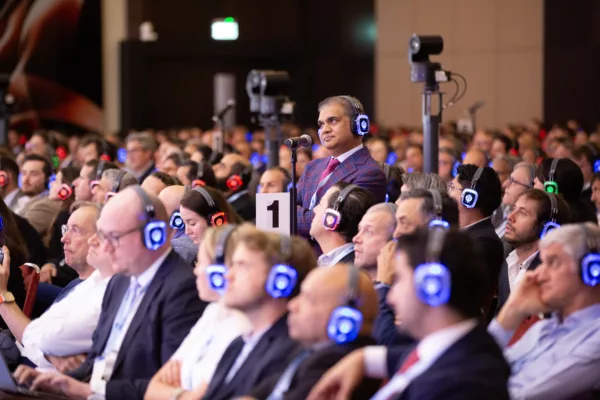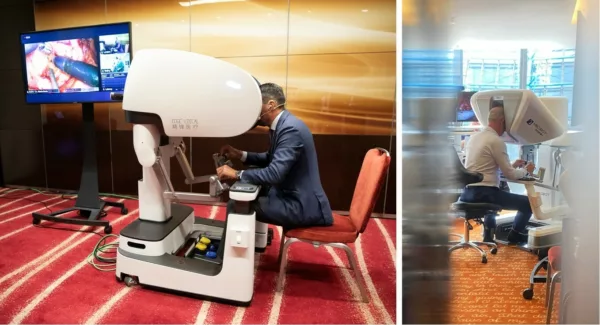Day 2 at ERUS25: Telesurgery brings the world to London
While at ERUS24 in Bordeaux we could celebrate a first for an EAU event - Prof. Alberto Breda operating on a patient in Beijing from a local hospital - only one year later things are already developing rapidly. We not only saw a repeat performance of this procedure, but Prof. Breda was joined by Prof. Alex Mottrie operating from London on a patient in his home centre in Aalst, and Dr. Sudhir Rawal in New Delhi operating on a patient in a local hospital while he was at the Mantra HQ a few kilometers away.
Three simultaneous telesurgical cases, one of which was then also transmitted from across the globe really connected the world’s urological experts to an auditorium in central London. Questions and comments from the moderators and audience further enhanced this dynamic as the surgeons shared their experiences in this new field.
Reality and potential
Prof. Mottrie was performing a robotic-assisted radical prostatectomy from London on a patient in Aalst, using a MicroPort MedBot system. Dr. Geert De Naeyer was in the operating theatre as a back-up, overseeing the local team. The session was moderated by Prof. Imran Ahmad (Glasgow, GB) and Dr. Ananthakrishnan Sivaraman (Celebration, US), who probed Prof. Mottrie on the logistics as well as the practical and ethical considerations of telesurgery. Dr. Vipul Patel (Celebration, US) also shared his own experiences and insights from the audience.
While it is clear that technological barriers to telesurgery are rapidly being broken down and its feasibility has been demonstrated without a doubt (“here to stay” in the words of Prof. Mottrie), the implications for surgeons and patients are only just beginning to become clear.
Prof. Mottrie highlighted the potential for democratising healthcare, offering greater reach to the best surgeons to reach those that need it the most. A second major benefit of telesurgery is telementoring, helping beginning doctors with certain cases or even starting the training in a remote manner (instead of travelling to training centers for cadaver training and the like).
Prof. Mottrie envisioned a network of international hospitals, using the same (communication) protocols for remote surgery, allowing surgeons to seamlessly work together and help each other. Particularly within a single hospital (group) with various locations on a campus, where surgical protocols are identical, much travel time could be saved by on-call surgeons whose presence was required elsewhere.
Prof. Patel chimed in from the audience microphones regarding the logistics of establishing a suitable connection: “When we were filing for FDA approval, most of the questions were in the realm of telecom: cybersecurity, back-up relays and which protocols were in place in case a bad actor gained access. As the surgeon who is ultimately responsible you really have to understand these matters, which I never thought I’d be involved in.”
On the robotic systems currently capable of telesurgery, both Prof. Mottrie and Patel said that they use all the systems with confidence and without any clear limitations. While established companies offer more in terms of services or other “bells and whistles”, the newer companies have feasible systems and could even end up eclipsing existing systems in the coming years with the use of telesurgery, AI or VR applications.
Article continues below photos
The telesurgery patient
The session’s moderators discussed the counseling of patients who would not meet their surgeons face to face, and how consent is attained for this type of procedure. Prof. Ahmad asked his colleague if he envisioned Indian patients’ reactions to the telesurgical future that that country was entering. Are cultural issues also at play? Prof. Ahmad was on the fence if he would undergo surgery remotely, seeing the number of factors that could go wrong.
There was also the ethical matter of having a completely trained robotic surgeon as a local “back-up”, why could this surgeon not treat patients directly? In the discussion that followed, parallels were drawn with having an (almost always unused) open surgery back-up plan in the robotic OR.
Dr. De Naeyer told the audience from Aalst that their patients are explained in detail the logistics of the connection, servers, trained team and so on. Getting consent is not difficult and does not differ much from how consent is given for live surgery transmission, as ERUS and other EAU events have made use of for educational purposes for nearly 20 years.
Prof. Patel did acknowledge that patient consent is a difficult matter: “It’s hard to counsel a patient because we don’t yet understand all the back-ups and security risks. When you tell patients, they tend to agree because they don’t know. Surgeons often don’t either.”
In conclusion: the field is rapidly evolving and the maturing technology is in search of potential applications. Ethical and legal barriers are the largest hurdles for proponents of telesurgery.
For more reports and news from the meeting in London, you can visit the ERUS25 news section.

